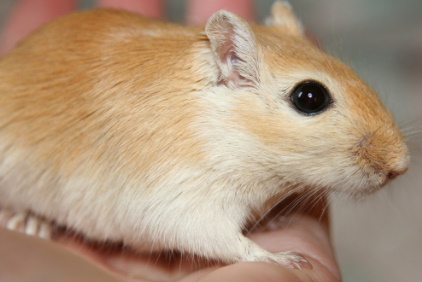Mongolian Gerbil Behaviour
Gerbils are very active rodents with a strong sense of curiosity and are friendly towards humans. They are voracious chewers and burrowers; it is important to supply pet gerbils with plenty of chewing material and a deep layer of substrate.
Mongolian gerbils make excellent, friendly pets that must have same-sex company. Some keepers report that girls have a higher chance of declanning in later life than boys.
Male gerbils can be stable in groups of up to four, whereas for girls it is best to keep only a pair as they are more likely to declan in later life.
Mongolian Gerbil behaviour is extremely territorial. You can never introduce a single gerbil to an established group - it will be killed. The only exception to this is when a pair of just weaned pups is introduced to a lone adult male. A single gerbil can be introduced to another single gerbil, or a pair to a pair, using a split-cage
Boxing
Boxing gerbils will stand on hind legs and push at the other gerbil. This is a way of establishing dominance without injury and both males and females will display this behaviour.
Fighting
As mentioned above, an adult single gerbil can only be introduced safely to another adult gerbil using the split-cage method. However even established groups can declan, and fighting between gerbils can be extremely serious. This can occur when the dominant gerbil becomes older, or even something as simple as one gerbil being handled more than the other. If one gerbil chases another without stopping to do any other action, if blood is drawn, or if you see most seriously then roll into a ball together you will need to intervene. A pair of gardening gloves is useful to help separate them since gerbils can bite quite hard. If blood has been drawn, or a ball occurred, then you will need to separate and consider reintroducing via a split-cage.
Foot thumping
This drumming sound is produce by a gerbil thumping its hind feet and is a method they use to communicate. It can indicate when they are frightened or startled, but also sexual excitement.
High nose
If a gerbil is curious they may stand on their hind legs, with front paws held loosely apart - if their posture is stiffer, with paws held tightly together, then they have been startled and are on alert.
Stereotypical burrowing
You may see your gerbil burrowing constantly in the corner of their tank. This compulsion does not harm your gerbil and you can distract them. Recent scientific papers have now shown that if gerbils are raised in an artificial burrow system that they then do not develop this behaviour at all.
Slow-motion
Some gerbils will display this behaviour when startled, and they seem to move in slow motion or in fits and starts.
Scent gland marking
Gerbils have a scent mark on their bellies and they will rub this across items in the tank and on other gerbils to mark them. Excessive scent marking can lead to fighting or the gerbil developing a scent gland tumour so it needs careful monitoring.

